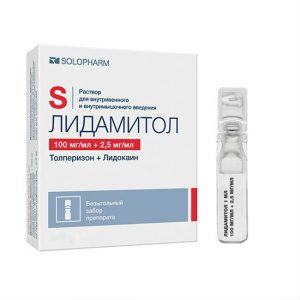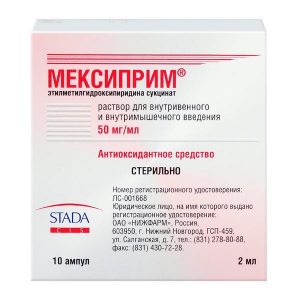Description
Latin name
Plisil
Release form
Tablets, film-coated, yellow to orange, round, engraved with POT 20 on one side and notch on both sides.
Packing
In a carton package 30 tablets of 20 mg.
Pharmacological Action
Antidepressant. Paroxetine is a powerful and selective inhibitor of serotonin reuptake (5-hydroxytryptamine, 5-HT) by brain neurons, which determines its antidepressant effect and effectiveness in the treatment of obsessive-compulsive and panic disorder. The main metabolites of paroxetine are polar and conjugated products of oxidation and methylation, which are rapidly excreted from the body, have weak pharmacological activity and do not affect the therapeutic effect. When paroxetine is metabolized, selective uptake of 5-HT by neurons due to its action is not disturbed.
Paroxetine has a low affinity for m-cholinergic receptors.
Possessing a selective effect, unlike tricyclic antidepressants, paroxetine is characterized by low affinity for 1, 2, -adrenoreceptors, as well as dopamine, 5-HT1-like, 5-HT2-like and histamine H1 receptors. Paroxetine does not violate psychomotor functions and does not potentiate the inhibitory effect of ethanol on them. Unlike antidepressants, which inhibit norepinephrine uptake, paroxetine suppresses the antihypertensive effects of guanethidine much less.
Suction.
After oral administration, paroxetine is well absorbed from the digestive tract. It is metabolized the first time it passes through the liver.
distribution.
Css is reached by 7-14 days after the start of treatment, the pharmacokinetics during prolonged treatment does not change. The clinical effects of paroxetine (side effects and efficacy) do not correlate with its plasma concentration. Paroxetine is extensively distributed in tissues, and pharmacokinetic calculations show that only 1% of it is present in plasma. In therapeutic concentrations, the binding of paroxetine to plasma proteins is 95%.
Metabolism.
Since the metabolism of paroxetine involves the first passage through the liver, its amount, determined in the systemic circulation, is less than that absorbed from the digestive tract. With an increase in the dose of paroxetine or with repeated administration, when the load on the body increases, there is a partial absorption of the effect of the first passage through the liver and a decrease in the plasma clearance of paroxetine. As a result of this, an increase in the concentration of paroxetine in the plasma and fluctuations in the pharmacokinetic parameters are possible, which can be observed only in those patients who, when taking the drug in low doses, achieve low concentrations of paroxetine in the plasma.
Withdrawal.
T1 / 2 varies, but usually is about 16-21 hours. The excretion of paroxetine metabolites from the body is biphasic, first as a result of metabolism during the first passage through the liver, and then it is controlled by systemic elimination. Paroxetine is excreted mainly in the form of metabolites: 64% of the metabolites are excreted in the urine and 36% through the intestines, probably with bile. Less than 2% with urine and less than 1% with bile are excreted unchanged.
Indications
Depression of various etiologies, obsessive compulsive conditions, panic disorders.
Contraindications
concomitant use of MAO inhibitors and up to 14 days after they are discontinued
pregnancy
lactation (breastfeeding)
children and adolescents under 18 years of age (efficacy and safety not established)
hypersensitivity to the drug components.
With caution, the drug should be prescribed for hepatic and renal failure, angle-closure glaucoma, prostate hyperplasia, mania, cardiac pathology, epilepsy (with unstable epilepsy, the drug should be avoided), convulsive conditions, during electropulse therapy, while taking drugs that increase the risk of bleeding , in the presence of risk factors for increased bleeding and diseases, increasing the risk of bleeding in elderly patients.
Use during pregnancy and lactation
The drug is contraindicated during pregnancy and during lactation (breastfeeding).
Composition
1 tablet contains paroxetine mesylate 25.83 mg, which corresponds to a paroxetine content of 20 mg.
Excipients: calcium hydrogen phosphate anhydrous, sodium carboxymethyl starch, magnesium stearate.
Composition of the film coat: lactose monohydrate, hypromellose, titanium dioxide (E171), macrogol 4000, iron oxide yellow (E172), iron oxide red (E172).
Dosage and administration
The drug is taken orally 1 time / day. in the morning while eating. The tablet is swallowed whole, washed down with water. The dose is selected individually during the first 2-3 weeks after the start of therapy and subsequently adjusted if necessary.
For depression, the drug is prescribed in a dose of 20 mg 1 time / day. If necessary, the dose is gradually increased by 10 mg / day. , the maximum daily dose is 50 mg, depending on the response of the patient.
For obsessive-compulsive disorders, the initial therapeutic dose is 20 mg / day. , followed by a weekly increase of 10 mg. The recommended average therapeutic dose is 40 mg / day. , if necessary, the dose can be increased to 60 mg / day.
For panic disorders, the drug is prescribed in an initial dose of 10 mg / day. (to reduce the possible risk of developing exacerbation of panic symptoms), followed by a weekly increase of 10 mg. The average therapeutic dose is 40 mg / day. The maximum dose is 50 mg / day.
Social Anxiety Disorders / Sociophobia: The initial dose is 20 mg / day. , in the absence of effect for at least 2 weeks, it is possible to increase the dose to a maximum of 50 mg / day. The dose should be increased by 10 mg at intervals of at least 1 week in accordance with the clinical effect.
In post-traumatic mental disorders, for most patients, the initial and therapeutic doses are 20 mg / day. In some cases, increasing the dose of paroxetine to a maximum of 50 mg / day is recommended. The dose should be increased by 10 mg every week in accordance with the clinical effect.
In generalized anxiety disorders, the initial and recommended doses are 20 mg / day.
For renal and / or liver failure, the recommended daily dose is 20 mg.
For elderly patients, the daily dose should not exceed 40 mg.
The dose of the drug should be evaluated and, if necessary, adjusted within 2-3 weeks at the beginning of therapy, and then as necessary. Patients should continue treatment for a period sufficient for the symptoms to disappear for at least 4-6 months after recovery from depression or more – in the presence of obsessive-compulsive and panic disorders. As with many other psychotropic drugs, abrupt drug withdrawal is not recommended.
The use of paroxetine in children is not recommended because its safety effectiveness in this population has not been established.
Side effects of the
From the nervous system: drowsiness, tremor, asthenia, insomnia, dizziness, fatigue, convulsions, extrapyramidal disorders, hallucinations, mania, confusion, agitation, anxiety, depersonalization, panic attacks, anxiety, anxiety, panic anxiety, concentration of attention, serotonin syndrome.
From the musculoskeletal system: arthralgia, myalgia, myopathy, myasthenia gravis.
On the part of the sensory organs: impaired vision, a change in taste.
From the genitourinary system: sexual dysfunction, including impotence and ejaculation disorder, decreased libido, anorgasmia, urinary retention, increased urination.
From the digestive system: decreased appetite, nausea, vomiting, dry mouth, constipation or diarrhea, in very rare cases, hepatitis.
From the CCC side: orthostatic hypotension.
Other: increased sweating, allergic reactions (rash, urticaria, ecchymosis, pruritus, angioedema), hyponatremia, impaired secretion of ADH, hyperprolactinemia / galactorrhea, withdrawal symptoms during sudden drug withdrawal.
Drug Interaction
Food intake and antacids do not affect the absorption and pharmacokinetic parameters of the drug. Paroxetine is incompatible with MAO inhibitors, thioridazine.
When co-administered with paroxetine, procyclidine concentrations are increased.
During treatment, the patient should refrain from drinking alcohol due to the potential for increased toxicity of ethanol.
When co-administered with inducers / inhibitors of liver enzymes, metabolism and pharmacokinetics of paroxetine may be altered.
Due to the inhibition of paroxetine isoenzymes of the cytochrome P450 system, the effect of barbiturates, phenytoin, indirect anticoagulants, tricyclic antidepressants (nortriptyline, amitriptyline, imipramine, desipramine and fluoxetine), neyrotyptine, neyrotyptine, neyroptazine and fluoxetine, may be enhanced ), metoprolol and increased risk of side effects while co-administering these drugs.
When administered concomitantly with drugs that inhibit liver enzymes, paroxetine dose reduction may be required.
Paroxetine increases bleeding time against warfarin, with prothrombin time unchanged.
When co-administered with paroxetine with atypical antipsychotics, phenothiazines, tricyclic antidepressants, acetylsalicylic acid, NSAIDs are advised to exercise caution in connection with possible disorders of blood coagulation.
When administered with serotonergic drugs (tramadol, sumatriptan), serotonergic effects may be enhanced.
Mutual enhancement of tryptophan, lithium and paroxetine preparations (as with the appointment of other selective serotonin reuptake inhibitors) was noted. Co-administration with lithium preparations should be carried out under the control of their concentration of lithium in blood plasma. Co-administration with tryptophan-containing drugs is not recommended.
The use of paroxetine (as well as other selective serotonin reuptake inhibitors) with neuroleptics may lead to the development of ZNS.
When paroxetine is co-administered with phenytoin and other anticonvulsants, it is possible to reduce the plasma concentration of paroxetine and to increase the incidence of side effects.
Overdose
Symptoms: nausea, vomiting, tremor, dry mouth, enlarged pupils, fever, changes in blood pressure, headache, involuntary muscle contractions, agitation, anxiety, sinus tachycardia, sweating, drowsiness, drowsiness, drowsiness, drowsiness. In very rare cases, at the simultaneous reception with other psychotropic agents and / or alcohol changes on an ECG, a coma are possible.
Treatment: gastric lavage, activated charcoal appointment. If necessary – carrying out symptomatic therapy. There is no specific antidote.
Storage conditions
List B. In a dry place, at a temperature not exceeding 30 ° C.
Shelf suitability
3 Year
Deystvuyuschee substances
Paroxetine
Pharmacy terms
Prescription
Dosage form
Dosage form
tablets




